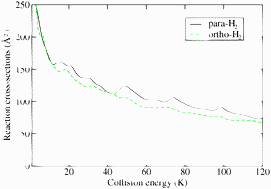Reactive cross-sections for the collision of open shell S(1D) atoms with ortho- and para-hydrogen, in the kinetic energy range 1–120 K, have been calculated using the hyperspherical quantum reactive scattering method developed by Launay et al. [Chem. Phys. Lett., 1990, 169, 473]. Short-range interactions, described using the ab initio potential energy surface by Hoet al. [J. Chem. Phys., 2002, 116, 4124], were complemented with an accurate description of the long-range interactions, where the main electrostatic (∼R−5) and dispersion (∼R−6) contributions were considered. This allows the comparison with recent experimental measurements of rate constants and excitation functions for the title reaction at low temperatures [Berteloite et al., Phys. Rev. Lett., 2010, 105, 203201]. The agreement is fairly good. The behavior in the considered energy range can be understood on average in terms of a classical Langevin (capture) model, where the centrifugal barriers determine the amount of reactive flux which reaches the barrierless transition state. Additionally, the structure of the van der Waals well provides temporal trapping at intermediate intermolecular distances thus allowing the system to find its way to the reaction at some classically-forbidden energies. Interestingly, the cross-section for para-hydrogen shows clearly oscillating features associated with the opening of new partial waves and with shape resonances which may be amenable to experimental detection.


 Please wait while we load your content...
Please wait while we load your content...